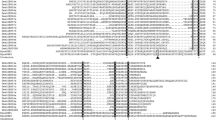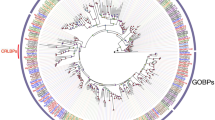Abstract
We have identified and cloned the cDNAs encoding two odorant-binding proteins (OBPs) from the American palm weevil (APW) Rhynchophorus palmarum (Coleoptera, Curculionidae). Degenerate primers were designed from the N-terminal sequences and were used in polymerase chain reaction (PCR) in order to obtain full-length sequences in both males and females. In both sexes, two different cDNAs were obtained, encoding 123 and 115 amino acid-deduced sequences. Each sequence showed few amino acid differences between the sexes. The proteins were named RpalOBP2 and RpalOBP4 for male, RpalOBP2' and RpalOBP4' for female, with the types 2 and 4 presenting only 34% identities. These proteins shared high identity with previously described coleopteran OBPs. In native gels, RpalOBP2 clearly separated into two bands and RpalOBP4 into three bands, suggesting the presence of several conformational isomers. Thus, OBP diversity in this species may rely on both the presence of OBPs from different classes and the occurrence of isoforms for each OBP.
Similar content being viewed by others
REFERENCES
Carlsson, M. A. and Hansson, B. S. 2002. Responses in highly selective sensory neurons to blends of pheromone components in the moth Agrotis segetum. J. Insect Physiol. 48:443–451.
Combet, C., Blanchet, C., Geourjon, C., and Deleage, G. 2000. NPS@: Network protein sequence analysis. Trends Biochem. Sci. 25:147–150.
Deyu, Z. and Leal, W. S. 2002. Conformational isomers of insect odorant-binding proteins. Arch. Biochem. Biophys. 397:99–105.
Du, G. and Prestwich, G. D. 1995. Protein structures encode the ligand binding specificity in pheromone binding proteins. Biochemistry 34:8726–8732.
Griffith, R. 1987. Red ring disease of coconut palm. Plant Dis. 71:193–196.
Hernandez, J. V., Cerda, H., JaffÉ, K., and Sanchez, P. 1992. Localizacion hospedera, actividad diaria y optimizacion de la captura del picudo del cocotero Rhynchophorus palmarum L. (Coleoptera/Curculionidae), mediante trampas inocuas. Agron. Trop. (Venezuela) 42:211–226.
Jacquin-Joly, E., Bohbot, J., Francois, M.-C., Cain, A.-H., and Nagnan-Le Meillour, P. 2000. Characterization of the general odorant binding protein 2 in the molecular coding of odorants in Mamestra brassicae. Eur. J. Biochem. 267:6708–6714.
Jaf \(\begin{gathered} \prime \hfill \\ {\text{F}} \hfill \\\end{gathered}\) e, K., Sanchez, P., Cerda, H., Hernandez, J. V., Jaf \(\begin{gathered} \prime \hfill \\ {\text{F}} \hfill \\\end{gathered}\) e, R., Urdaneta, N., Guerra, G., Martinez, R., and Miras, B. 1993. Chemical ecology of the palm weevil Rhynchophorus palmarum (L.) (Coleoptera: Curculionidae): Attraction to host plants and to a male-produced aggregation pheromone. J. Chem. Ecol. 19:1703–1720.
Leal, W. S., Nikonova, L., and Peng, G. 1999. Disulfide structure of the pheromone binding protein from the silkworm moth, Bombyx mori. FEBS Letts. 464:85–90.
Maida, R., Krieger, J., Gebauer, T., Lange, U., and Ziegelberger, G. 2000. Three pheromone-binding proteins in olfactory sensilla of the two silkmoth species Antheraea polyphemus and Antheraea pernyi. Eur. J. Biochem. 267:2899–2908.
Merritt, T. J., LaForest, S., Prestwich, G. D., Quattro, J. M., and Vogt, R. G. 1998. Patterns of gene duplication in lepidopteran pheromone binding proteins. J. Mol. Evol. 46:272–276.
Mohl, C., Breer, H., and Krieger, J. 2002. Species-specific pheromonal compounds induce distinct conformational changes of pheromone binding protein subtypes from Antheraea polyphemus. Invert. Neurosci. 4:165–174.
Nagnan, P., Cain, A. H., and Rochat, D. 1992. Extraction and identification of volatile compounds of fermented oil palm sap (palm wine), candidate attractants for the palm weevil. Oléagineux 47:135–142.
Nagnan-Le Meillour, P., Huet, J.-C., Maibeche, M., Pernollet, J.-C., and Descoins, C. 1996. Purification and characterization of multiple forms of odorant/pheromone binding proteins in the antennae of Mamestra brassicae (Noctuidae). Insect Biochem. Mol. Biol. 26:59–67.
Nagnan-Le Meillour, P. and Jacquin-Joly, E. 2003. Biochemistry and diversity of insect odorant-binding proteins, Chap.17, in G. Blomquist and R. G. Vogt (eds.). Insect Pheromone Biochemistry and Molecular Biology. Elsevier, Oxford.
Newcomb, R. D., Sirey, T. M., Rassam, M., and Greenwood, D. R. 2002. Pheromone binding proteins of Epiphyas postvittana (Lepidoptera: Tortricidae) are encoded at a single locus. Insect Biochem. Mol. Biol. 32:1543–1554.
Nikonov, A. A., Peng, G., Tsurupa, G., and Leal, W. S. 2002. Unisex pheromone detectors and pheromone-binding proteins in scarab beetles. Chem. Senses 27:495–504.
Oehlschlager, A. C., Chinchilla, C. M., Gonzalez, L. M., Jiron, L. F., Mexzon, R., and Morgan, B. 1993. Development of a pheromone-based trapping system for Rhynchophorus palmarum (Coleoptera: Curculionidae). J. Econ. Entomol. 86:1381–1392.
Peng, G. and Leal, W. S. 2001. Identification and cloning of a pheromone-binding protein from the Oriental beetle, Exomala orientalis. J. Chem. Ecol. 27:2183–2192.
Rochat, D., Descoins, C., Malosse, C., Nagnan, P., Zagatti, P., Akamou, F., and Mariau, D. 1993. Ecologie chimique des charançons des palmiers, Rhynchophorus spp. (Coleoptera). Oléagineux 48:225–236.
Rochat, D., Gonzalez, A. V., Mariau, D., Villanueva, A. G., and Zagatti, P. 1991a. Evidence for male-produced aggregation pheromone in american palm weevil, Rhynchophorus palmarum (L.) (Coleoptera: Curculionidae). J. Chem. Ecol. 17:1221–1230.
Rochat, D., Malosse, C., Lettere, M., Ducrot, P. H., Zagatti, P., Renou, M., and Descoins, C. 1991b. Male-produced aggregation pheromone of the american palm weevil, Rhynchophorus palmarum (L.) (Coleoptera: Curculionidae): Collection, identification, electrophysiological activity, and laboratory bioassay. J. Chem. Ecol. 17:2127–2141.
Rochat, D., Nagnan-Le Meillour, P., Esteban-Duran, J. R., Malosse, C., Perthuis, B., Morin, J.-P., and Descoins, C. 2000. Identification of pheromone synergists in american palm weevil Rhynchophorus palmarum, and attraction of related Dynamis borassi. J. Chem. Ecol. 26:155–187.
Said, I. 2003. Etude de la réponse synergique au signal phéromone-kairomone chez le charançon du palmier: Rhynchophorus palmarum L. (Coleoptera, Curculionidae): Approches olfactométrique et électrophysiologique. Thèse de Doctorat de l'ENSA Rennes, 119 p.
Said, I., Tauban, D., Renou, M., Mori, K., and Rochat, D. 2003. Structure and function of the antennal sensilla of the palm weevil Rhynchophorus palmarum (Coleoptera, curculionidae). J. Insect Physiol. 49:857–872.
Sanchez, P., Cerda, H., Cabrera, A., Caetano, F. H., Materan, M., Sanchez, F., and JaffÉ, K. 1996. Secretory mechanisms for the male produced aggregation pheromone of the palm weevil Rhynchophorus palmarum L. (Coleoptera: Curculionidae). J. Insect Physiol. 42:1113–1119.
Scaloni, A., Monti, M., Angeli, S., and Pelosi, P. 1999. Structural analysis and disulfide bridge pairing of two odorant-binding proteins from Bombyx mori. Biochem. Biophys. Res. Commun. 266:386–391.
Wojtasek, H., Hansson, B. S., and Leal, W. S. 1998. Attracted or repelled?—A matter of two neurons, one pheromone binding protein, and a chiral center. Biochem. Biophys. Res. Commun. 250:217–222.
Wojtasek, H., Picimbon, J.-F., and Leal, W. S. 1999. Identification and cloning of odorant binding proteins from the scarab beetle Phyllopertha diversa. Biochem. Biophys. Res. Commun. 263:832–837.
Author information
Authors and Affiliations
Corresponding author
Rights and permissions
About this article
Cite this article
Meillour, P.NL., François, MC. & Jacquin-Joly, E. Identification and Molecular Cloning of Putative Odorant-Binding Proteins from the American Palm Weevil, Rhynchophorus palmarum L.. J Chem Ecol 30, 1213–1223 (2004). https://doi.org/10.1023/B:JOEC.0000030273.77407.4d
Issue Date:
DOI: https://doi.org/10.1023/B:JOEC.0000030273.77407.4d




